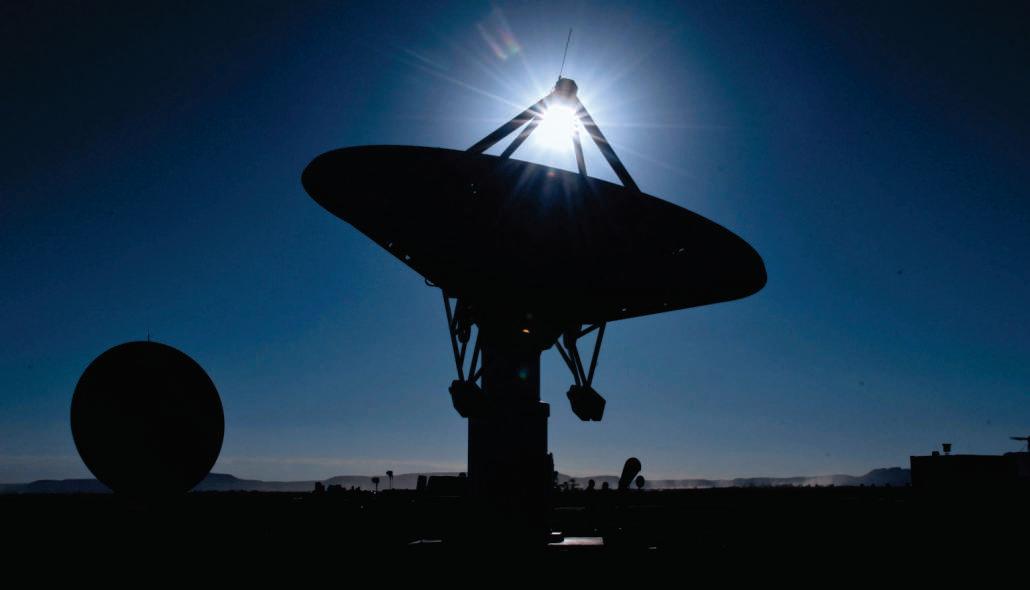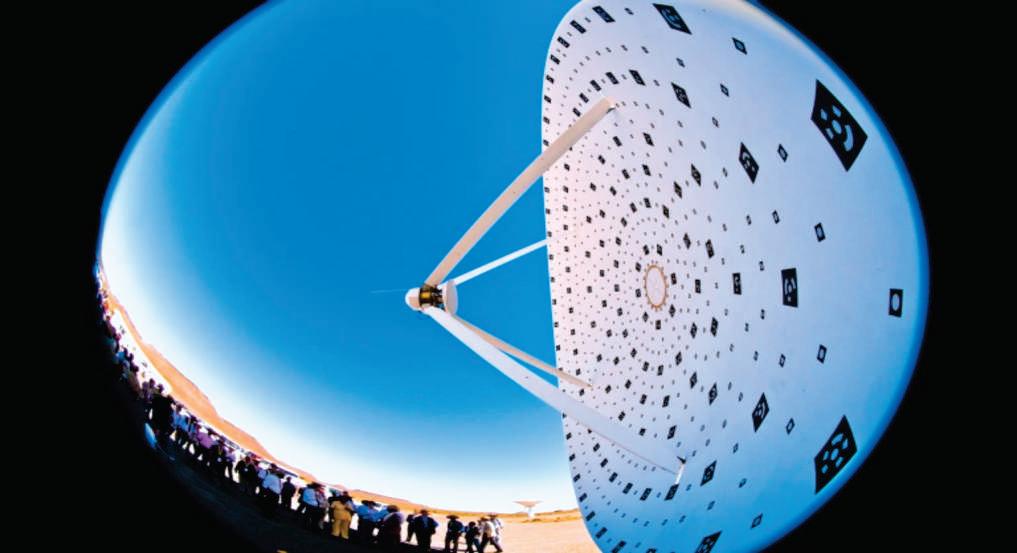
3 minute read
Moenie onkant gevang word nie
2023
Last week the Royal Astronomical Society awarded the MeerKATteam the 2023 GroupAchievementAward ‘for a series of spectacular observations in radio astronomy, the highlight being the images of the Galactic Centre region and the spectacular radio bubbles’.
Advertisement
There is a picture on Dr Fernando Camilo’s office wall of a smug President Cyril Ramaphosa, who is perhaps being a bit of a show-off.
Asmiling Ramaphosa is standing next to his subdued Chinese counterpart, Xi Jinping, and behind the two statesmen is a blown-up photograph of a South African success story
What it is, is the clearest-yet image of the centre of the Milky Way, which is a good 25,000 light years from the Karoo, in the heartland of SouthAfrica, from where the MeerKATradio telescope snapped it.
That image came about when Camilo and his team decided to take the then new MeerKATradio telescope for a spin and pointed it to a corner of the southern sky.
In the past, other radio telescopes had battled to penetrate the dust and gas that shrouded the centre of the Milky Way
Money shot
But the MeerKATteam got the money shot. What they achieved was an image drawn not by light, but by radio and x-rays, of a black hole and strange filamentlike structures.
Five years later, and that image, says Camilo, is still the clearest shot of the centre of our galaxy
But what Camilo and his colleagues didn’t know then was that those 64 antennas staring up at Karoo sky also captured something else.
The scientists analysing the same data that produced the shot of the centre of the Milky Way found giant radio bubbles. Bubbles so big they stretched 1,400 light years across … and they had never been spotted before.
“The shape and symmetry of what we have observed strongly suggest that a staggeringly powerful event happened a few million years ago, very near our galaxy’s central black hole,” declared astronomer William
Cotton, one the team that observed the phenomenon, when the discovery was announced back in 2019.
Politicians have used MeerKAT’s achievements for photo opportunities and just over a week ago it was science’s turn to acknowledge the achievements of the team that has been making some remarkable findings.
2023 GroupAchievementAward
The RoyalAstronomical Society awarded the MeerKATteam the 2023 GroupAchievementAward
“for a series of spectacular observations in radio astronomy, the highlight being the images of the Galactic Centre region and the spectacular radio bubbles”.
“It is nice to have a stamp of recognition from the professional societies that was really very cool,” says Camilo, who is chief scientist at the SouthAfrican RadioAstronomy Observatory
July will mark the fifth anniversary of the inauguration of MeerKATand, for those working on the project, it has been a busy, exciting time.
So far the scientists involved with MeerKAThave published 180 journal articles.
“Those 180 papers are a small fraction of all the data that has already been collected, there are hundreds of papers in the pipeline that will come out in the next couple of years,” explains Camilo.
One of the team members involved with MeerKATin the beginning was astronomer Dr Tana Joseph.
She likes to borrow an oddball phrase from the former US defence secretary Donald Rumsfeld, when she talks of MeerKAT
“It is all about the unknown knowns; that is what captivates me. We are seeing those unknowns, and that is fun and so cool,” she laughs.
MeerKATis chalking up discoveries that astronomers didn’t know about.
“The theory has to maybe catch up with the observations,” she adds.
Joseph is quick to point out that the team behind these discoveries comprises a whole ecosystem of software engineers, big data scientists and other technicians who make sure that the radio telescope keeps eavesdropping on the universe.
And those new discoveries are set to continue, especially as MeerKATis in the middle of an upgrade.
The telescope is getting 16 new antennas.And with 80 antennas, MeerKATwill be able to see even further and clearer
If all goes to plan, the new additions will come online next year or in early 2025.
With those extra ears pointed to the sky listening for radio waves, Camilo explains, MeerKATwill become ideally suited to the hunt for hydrogen, an element that is abundant throughout the universe but is very difficult to find. “Hydrogen is the simplest element in the universe. It is the fuel that makes up stars, but the gas is very hard to detect out there in space. It actually emits these very, very faint radio waves, which makes MeerKAT the best telescope in the world for detecting it right now,” he says.
Development spin-off
As the project has grown since its inception more than a decadeand-a-half ago, there has been another spin-off, away from the radio-wave pictures of far-away galaxies.
“We not only built a telescope, but my colleagues here spent a lot of effort in developing the team here in SouthAfrica, and now, 15 years later, from a point when we just had a handful of astronomers, there are now dozens and dozens spread around universities across South Africa,” says Camilo.
In time MeerKATis set to become part of the Square KilometreArray, an international project that is being built in Australia and SouthAfrica.

“Sadly for those of us who loved MeerKATsince the beginning, MeerKATas a standalone instrument will cease to exist,” says Camilo. “But we don’t know when that will happen, and we still have several years of this decade with MeerKAT, so we are trying to squeeze as much great science out of it as we can.”
DM/OBP










